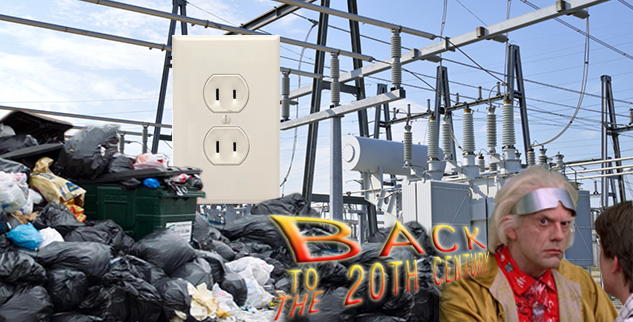
How can it be that our typical North American residential (and certainly industrial) AC power mains can be dirty? What is this so-called “dirt,” where does it come from, and is it something that affects me? Are there any health issues concerning electrical dirt?
How about a little hint up front on where the dirt comes from: You, or at least the utility consumers, anyhow.
But what is more important, even CRITICAL, is how does this affect the quality of your legacy media or home movie video transfer or duplication to digital. Why would we at W. Cardone Productions go to so much trouble to address the dirt on the North American power grid? Stay tuned and become informed on things that affect state of the art home movie transfers and duplication to digital.
What Is This So-called “Dirt,” Anyhow?
To identify “dirt” we should start by defining what is NOT dirt. What is “clean” AC mains electricity?
The discussion that follows, in parts, will be a little technical for some viewers. Honest, we have made every effort to think of clever ways to explain things and circumvent tech-talk. We will make every effort to make the discussion quick and as simple as possible but will include notes on where to skip ahead to.
Most North American electricity is generated by giant turbines that are made to spin by some means such as a hydro-electric dam, fossil fuels, or by the energy in nuclear powered steam. As the turbine armature rotates, its copper wires “cut magnetic lines of force” inducing a voltage in the wires according to Maxwell’s law. With each rotation of the armature the generated voltage goes from zero to a maximum (the first quarter turn), then down passing zero to a negative maximum (3/4 of a turn), and finally at the completion of one full turn back to zero.

In North America a turbine is made to rotate sixty times every second resulting in the 60Hz AC mains electric service we are all familiar with and depend on so much for virtually everything imaginable.
The illustration on the right shows a sine wave that is pure as the driven snow. “Dirt” is anything that alters that shape. Now that the reader knows what clean power is, let’s move on to dirt.
Show Me the Dirt
Look at a depiction of an actual residential AC mains service taken from service in Chelsea, Michigan. In the illustration below notice that the shape of the sine signal is not quite the theoretically clean sine signal that we would like to have. In particular, notice that the peaks have been scalped. Notice also that the slopes connecting the peaks have a somewhat straight-line appearance rather than the nicely curved shape of the theoretical sine function. Upon very careful inspection observe that as the signal approaches its either plus or minus maximum it “lands” softly at the peak. But when then leaving the peak we see an abrupt transition or corner as it begins a sudden descent/ascent to the opposing peak as if pushed off a cliff. In general we can say that the sine shape does not look pretty at all.
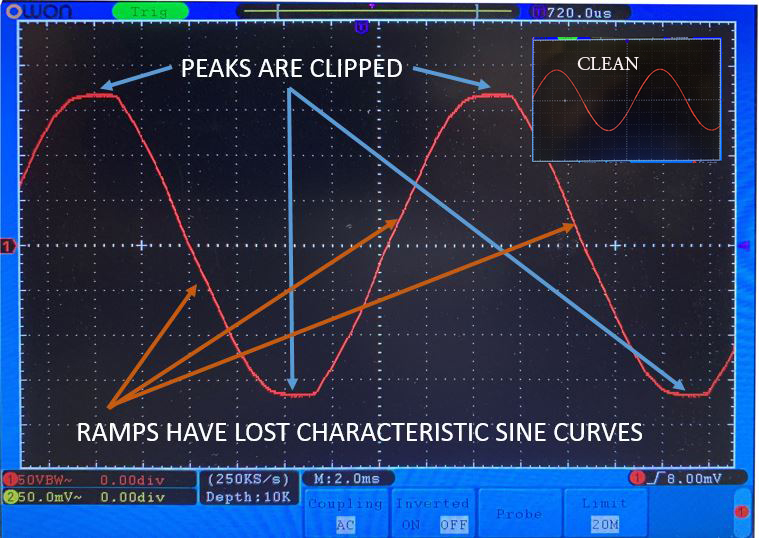
The next couple of paragraphs are more on the technical side so feel free to skip ahead to the next section titled Where Does This Dirt Come From. Nevertheless, this information is helpful in understanding from a high level perspective what the heck is going on with the North American power grid.
Let’s Do Some Detective Work
Now, beg the question, “Whence cometh this dirt?” To help answer this question we employ the use of a spectrum analyzer whose screen is shown below. The oscilloscope trace we saw earlier displayed the voltage magnitude and phase as a function of time. The spectrum analyzer displays the voltage peak as a function of frequency rather than time. In other words, while the oscilloscope displays all of the components summed together, the spectrum analysis instrument displays the same signal but as individual frequency components that make up the sum signal. The value of this is that we can see the frequency components of our AC mains residential service to get a better understanding of exactly what is making it so ugly. A perfect and clean utility service would have only the fundamental.
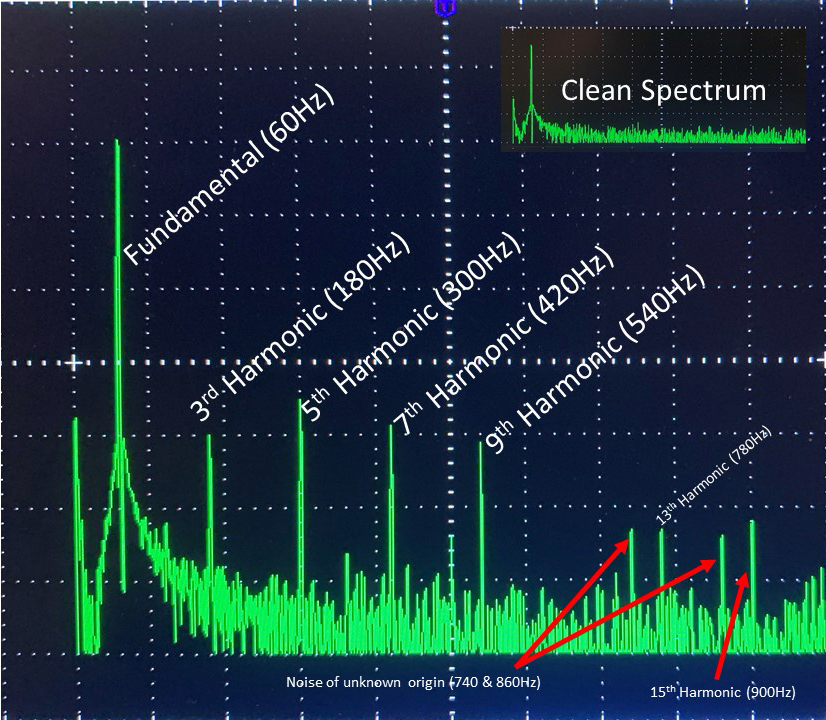
In the spectrum analysis, the screen is split up into increments representing 100Hz per division. We therefore see the fundamental (60Hz) with the massive spike inside the first division. The next component we see is a 180Hz signal (of much smaller magnitude than the fundamental), then 300Hz, then 420Hz, and so on. What is key to recognize is that these signals are exact harmonics of the fundamental. 180Hz is three times the fundamental of 60Hz. That component is therefore called the third harmonic. Note also the components are odd harmonics.
Do you think this is curious that there should be only components of precise odd multiples of the fundamental? This tells us something about the origin of the dirt. We have a clue.
Why Are the Odd Harmonics Going to be a Clue?
First, a square wave is a specified form of the more generalized “rectangular” wave. An oversimplified description of a square wave (having a specified frequency called the “fundamental”) is that it is merely a collection of sine waves summed together. Each of those component sine waves have a frequency that is an odd multiple of the fundamental. Thus, a 60Hz square wave is the result of a 60Hz (1x), 180Hz (3x), a 300Hz (5x), a 350Hz (7x) sine wave and continuing on at odd multiples to infinity, all summed together.
Summarizing, a rectangular wave is a collection of a whole bunch (infinite) of precisely defined sine waves. This concept is critical to take away in order to understand later in this article the source of our dirt.
Where Does this Dirt Come From?
It will help in identifying “whence commeth our dirt” if we first settle where it did NOT come from. Your first guess is likely the utility company itself. This is theoretically impossible since a turbine by its very physical nature turns out a sine source just as pure as the driven snow. Any dirt must enter the system outside or down stream of the power generation station.

Another possible source is the sun, Sole. We must rule out the sun since it would induce a broad spectrum of evenly divided frequencies. Our dirt is limited to the odd harmonics.
Another possible source would be an exo-atmospheric nuclear event, more commonly called EMP (electro-motive pulse). The characteristic of an EMP is on the order of several tens of nano-seconds single pulse event. Our dirt is not an event but is continuous. Besides, we haven’t seen in the news any announcement of an EMP event. Have you?

What about you and hundreds of millions of people like you? Ask yourself, “Have I been putting odd harmonics of a 60Hz fundamental out onto the national electric grid?” Before you answer too quickly, let’s explore what common household appliances and electronics generate harmonics like we are investigating.
Are you wondering if it could be your refrigerator? Consider refrigerators, air conditioners, de-humidifiers, and other appliances that use a compressor electric motor. These are the opposite of the utility company power generation turbine we read about earlier. If you could turn your refrigerator motor in the opposite direction it would become a turbine and generate electricity. These compressors therefore present what we call an “inductive” load to the AC mains coming into your house. It causes the current coming into your house to lag the voltage slightly creating a “power factor” less than unity but the load is a faithful sine shape without any harmonics. The reduced power factor represents wasted energy but at least it is not your loss. The meter at your home’s electric service entrance only records energy that you actually use. The wasted energy burden falls on the public utilities. But in any case we can rule out your refrigerator as a dirt generator.
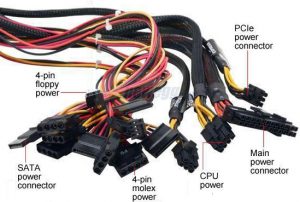
But what about your computer? Did you know that the computational part of your computer does not use ANY AC power whatsoever? Your computer runs exclusively on DC potential. What it DOES have, however, is a power supply that uses your AC mains service to develop a varied set of DC potentials that the computer runs on. The computer power supply is called a “switch-mode” power supply. The power supply at times will make sharp (rectangular, remember that word) energy demands from the AC mains it is plugged into. These “sharp demands,” being rectangular, are rich in harmonics. Some of these harmonics may escape onto your household grid, travel out of the house to the telephone pole, and go to the neighbors that share your utilities section transformer. Some will even cross the transformer onto the 7,200 Volt distribution wires connecting you, and other neighborhoods, to the power sub-station. But what if every house in all of North America had just one computer?

The computer example is merely that, an example. Since about the year 2000 residential electronics devices have skyrocketed. Each of these devices have a switch-mode power supply. These include TVs, network routers, WiFi devices, and other home entertainment devices. As a general rule, any device that uses a “wall wart” (illustrated at the right) likely has switch-mode power generation in some way associated with it. But guess what’s coming down the pike like a speeding locomotive? Can you pronounce the word “electric car?” And can you guess what electric cars have? If you guessed that electric cars have switch-mode power supplies to charge their batteries you are 100% correct. Hmmm… I wonder what happens harmonic-wise when we plug an electric car in to charge.
The reader about now is probably saying, “So, what’s the big deal with switch-mode power supplies?” The problem is that they typically demand power in short periodic bursts, typically twice for each voltage cycle or Hz or 120 times per second. The bursts are sharp and very… rectangular. Let’s see. Where have we heard that word “rectangular” before? The reader is now encouraged to ask him or her self, “What is this reminiscent of that I have already learned in this article?”

So, we are seeing rectangular waves, a relative of the famed square wave. But when you think about it, what is a square wave, anyhow? What are the components of a square wave? Could those components we are looking for possibly be… No. It couldn’t be! But it is: odd harmonics of a 60Hz fundamental.
But wait a minute. Since the year, maybe, 2000 these consumer devices have become increasingly more popular. Today there are bunches and bunches of these consumer devices in every home throughout North America. All of these devices, together, are placing dirt on the North American power grid.
Are There Health Issues?
 The “dirt” addressed in this article is only one form of dirt that can be found on a residential household electrical grid somewhat uniformly throughout the continental United States. There are no health issues to link to these odd harmonics of 60Hz found on the North American electrical grid.
The “dirt” addressed in this article is only one form of dirt that can be found on a residential household electrical grid somewhat uniformly throughout the continental United States. There are no health issues to link to these odd harmonics of 60Hz found on the North American electrical grid.
However, there is an entire array of different sorts of localized dirt resulting from improperly wired homes or other problems. These remain local and do not find their way much past the individual home or possibly a neighbor. Many of these have been shown to pose inductive health risks to the home residents. If there is any question concerning these, much information may be found on the internet when searching for “home electro-magnetic health.” Tests are simple to perform.
Does It Affect Me?
No, not much unless you expect stunningly superlative performance from audio and visual prosumer grade home entertainment electronics you may have. Another way it may affect the consumer is if he or she is using legacy electronics designed and manufactured in a day when the national power grid was a piece of art. It is possible, though unlikely, that our 21st century electric grid might cause some mode of performance loss but certainly no damage.
If it doesn’t affect me much, who does it affect?
The harmonics on the national electrical grid have shown a very great effect for us at W. Cardone Productions and in a very elusive way. They were elusive in that our stunning home movie video duplication quality was not affected, only the bottom line–$. It took much time to isolate the problems we were seeing to the national grid. After all, it is only natural to look for problems in equipment malfunctions, not the national grid.
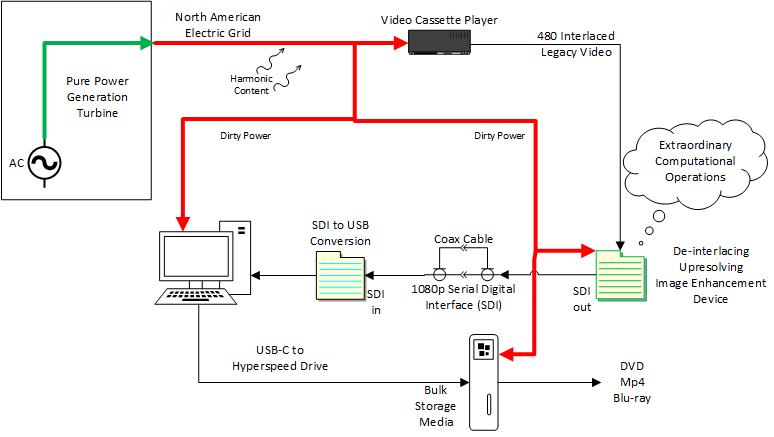
To understand why the grid harmonic dirt would affect a home movie download it is first necessary to grasp the nature of what we do. The original unsolved problem workflow is illustrated above. Briefly described, the legacy media home movie cassette video plays into an ultra sophisticated conversion device, then is captured to disk and further refined to varied consumer formats such as DVD, mp4, and Blu-ray. Four devices in the workflow need 120V AC power. Both the computer, the hyper drive bulk storage, and conversion devices are modern designs, designed to accept the typical North American dirty power. However, the VCR or other legacy media player was designed in a day when dirty power was not uniformly distributed throughout an entire region. Consequently, the video out signal is not as pure as it would have been in the year 2000. But even so, if the VHS player were merely sending a video signal to a TV the margin for error would be massive so there would be no problem whatsoever. Any image or audio quality loss would be humanly imperceptible.
The Problem is Finally Identified
Therein lies the problem. We have finally gotten to the crux of the matter. A legacy home movie video signal is being fed to an ultra sophisticated conversion device that performs miraculous tasks in real time as the media plays. Every so often a random event happens on the studio AC grid (the North American grid, that is) that pushes the conversion device outside of its envelope. It corrects for the video input imperfections but can only do so much.
The problem we were seeing was a random glitch (we didn’t know where) causing the conversion device to lose its sync and freeze, not accepting video at all. The download would have to be started from the beginning. This added an unacceptable impediment to the workflow. Yet we were not about to give up the absolutely superlative quality this workflow was affording in the production of home movie video duplication and transfer to digital. So, we just lived with it knowing that one day we would solve the problem.
In trouble shooting a random event, how many people would think to look to the North American power grid as the source of the problem.
Guess what… One day the problem was identified though with considerable heart ache along the way from pursuing dead ends. We had to fix the North American electric grid.
I Bet You Can’t Fix the National Grid
 Obviously we have no control or influence over the national power grid. We investigated a number of possibilities but none of the cheap ones were going to fix the problem.
Obviously we have no control or influence over the national power grid. We investigated a number of possibilities but none of the cheap ones were going to fix the problem.
First, the problem was that the VCR did not like 21st century power. It needed the equivalent of clean 20th century grade AC power. But the only reason that it needed clean power was that the sophisticated downstream conversion box was not tolerating video with random glitches. One must consider that the conversion box is a very advanced piece of equipment costing well over a thousand dollars. The conversion box is the heart and soul of what makes W. Cardone Productions unique in the industry. It has two primary overwhelming tasks. With each video frame that comes in there are two interlaced fields (250 lines each) originally captured 1/30th of a second apart. The box must assemble those two fields line-by-line such that each even line mates with perfection to its adjacent odd line. Next, each frame is up-resolved from 480 lines to 1080 lines of resolution. And finally there are miscellaneous enhancements done to each frame. For a full discussion of video interlacing and its significance to home movie video transfer to digital please see a very revealing blog post we have written on the subject: What’s All This “Interlaced” Stuff, Anyhow.
The conversion box could not tolerate the occasional random glitch coming from the dirty powered VCR. The solution therefore was to remove the dirtiness from the VCR’s AC power and to do it in a cost-effective fashion. Sadly, we did not find a cheap solution. One must consider that the harmonics we see on the grid have a very low impedance since they are coming to us courtesy of the grid itself.
And Now, The Solution
The solution we selected (not cheap) was…(drum roll, please)…a double-conversion uninterruptible power supply (DCUPS). Nobody in his right mind buys a DCUPS. They cost four times what a regular UPS costs and don’t have any special benefits other than producing crystal clear 60Hz AC power pure as the driven snow. See the illustration below for how the DCUPS was used within our modified topology to solve our random glitches.
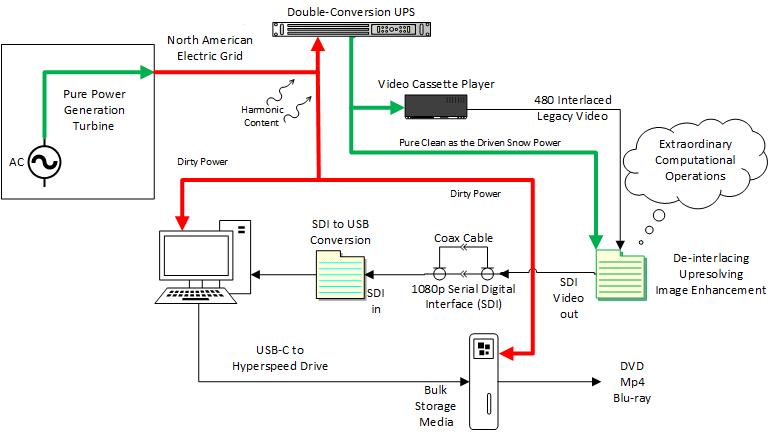
In the illustration above see that the AC supply path has been altered. Under the old topology, all devices were powered using the 60Hz dirty power taken directly off the electric service. In this updated topology we still use the unaltered utilities power but we added a device that would generate its own crystal clean 60Hz AC power using dirty power. Usually UPS units are meant to provide emergency power when the lights go out. In this configuration, however, the DCUPS will power the VCR and conversion box 24/7 as a permanent part of the configuration without regard to any power outages.
Conclusion
At W. Cardone Productions we could do a simple legacy video duplication to digital not bothering with de-interlacing or up-conversion as we had done for many years before this technology was available. In fairness, de-interlacing and up-resolving do not make a massive difference. Nevertheless, the difference is there and it is noticeable. We believe that our attention to these details is warranted in that our clients are preserving memories to pass on even to those yet unborn. This attention to imaging details distinguishes us among home movie video duplication and transfer services.
Please ask about a free duplication for competitive comparison purposes. Under the right circumstances we would be honored to show our stuff. Talk is cheap.
